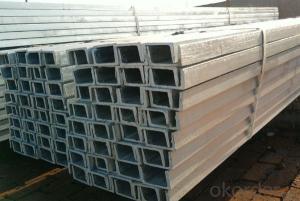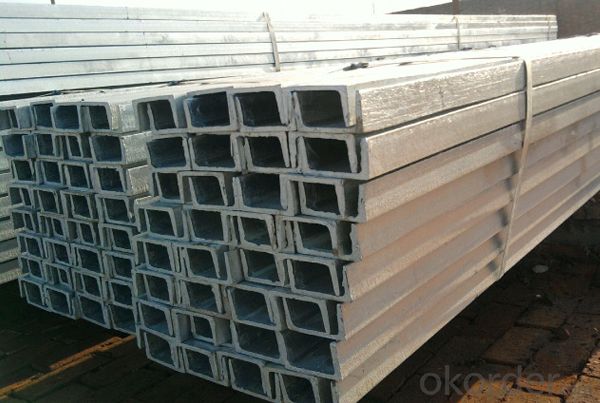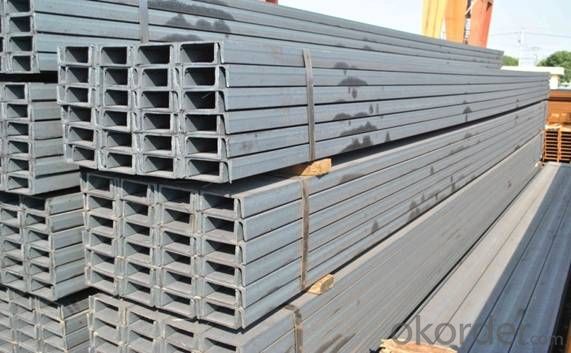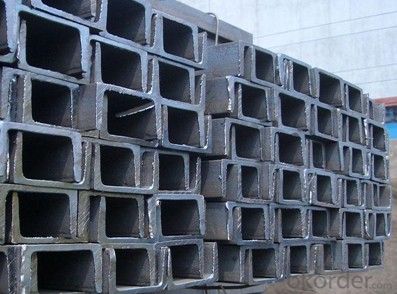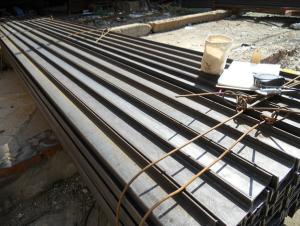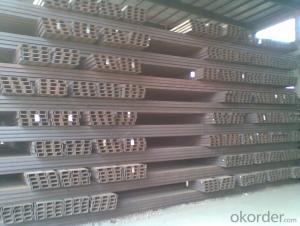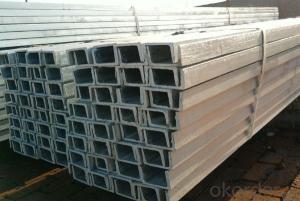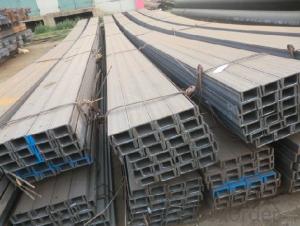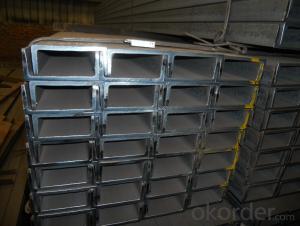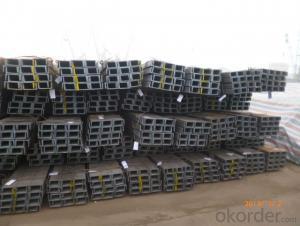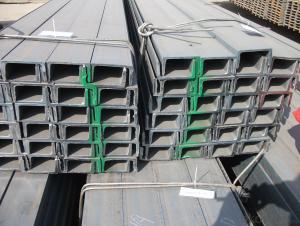U CHANNEL GB and JIS standard High Quality Hot Rolled
- Loading Port:
- Tianjin
- Payment Terms:
- TT or LC
- Min Order Qty:
- 25 m.t.
- Supply Capability:
- 20000000 m.t./month
OKorder Service Pledge
OKorder Financial Service
You Might Also Like
Product Description:
OKorder is offering high quality Hot Rolled Steel I-Beams at great prices with worldwide shipping. Our supplier is a world-class manufacturer of steel, with our products utilized the world over. OKorder annually supplies products to European, North American and Asian markets. We provide quotations within 24 hours of receiving an inquiry and guarantee competitive prices.
Product Applications:
The MS Channel can be applied to construction of warehouses, workshops, sport stadiums and car parks etc.The hot rolled channel steel belongs to carbon structural steel which is applied to in the field of construction and machinery.In details, the hot rolled channel steel is usually used for arch-itechtural structure, and they could be welded in order to support or hang a vari-ety of facilities. They are also usually used in combination with I beam. Generally,the hot rolled channel steel we supply must possess perfect welding property, riveting property and mechanical property and so on.
Product Advantages:
OKorder's
Product Description:
OKorder is offering high quality Hot Rolled Steel I-Beams at great prices with worldwide shipping. Our supplier is a world-class manufacturer of steel, with our products utilized the world over. OKorder annually supplies products to European, North American and Asian markets. We provide quotations within 24 hours of receiving an inquiry and guarantee competitive prices.
Product Applications:
The MS Channel can be applied to construction of warehouses, workshops, sport stadiums and car parks etc.The hot rolled channel steel belongs to carbon structural steel which is applied to in the field of construction and machinery.In details, the hot rolled channel steel is usually used for arch-itechtural structure, and they could be welded in order to support or hang a vari-ety of facilities. They are also usually used in combination with I beam. Generally,the hot rolled channel steel we supply must possess perfect welding property, riveting property and mechanical property and so on.
Product Advantages:
OKorder's channel are durable, strong, and resist corrosion, exact size, regular package, chemical and mechanical properties are stable.
Main Product Features:
· Premium quality
· Prompt delivery & seaworthy packing (30 days after receiving deposit)
· Corrosion resistance
· Can be recycled and reused
· Mill test certification
· Professional Service
· Competitive pricing
Product Specifications:
Manufacture: Hot rolled
Grade: BS4449
Certificates: ISO, SGS, BV, CIQ
Diameter: 6mm,8mm,10mm,12mm,14mm,16mm,18mm,20mm,
22mm,25mm,28mm,32mm,36mm,40mm,50mm
Length: 6M, 9M,12M or as required
Packaging: Export packing, nude packing, bundled
GB U CHANNEL | Standard | Sectional | Dimension |
| Mass: |
(mm) | (mm) | (mm) | (mm) | ||
50X37 | 50 | 37 | 4.50 | 7.0 | 5.438 |
63X40 | 63 | 40 | 4.80 | 7.5 | 6.634 |
80x43 | 80 | 43 | 5.00 | 8.0 | 8.045 |
100x48 | 100 | 48 | 5.30 | 8.5 | 10.007 |
120x53 | 120 | 53 | 5.50 | 9.0 | 12.059 |
140x58 | 140 | 58 | 6.00 | 9.5 | 14.535 |
140x60 | 140 | 60 | 8.00 | 9.5 | 16.733 |
160x63 | 160 | 63 | 6.50 | 10.0 | 17.240 |
160x65 | 160 | 65 | 8.50 | 10.0 | 19.752 |
180x68 | 180 | 68 | 7.00 | 10.5 | 20.174 |
180x70 | 180 | 70 | 9.00 | 10.5 | 23.000 |
200x73 | 200 | 73 | 7.00 | 11.0 | 22.637 |
200x75 | 200 | 75 | 9.00 | 11.0 | 25.777 |
220x77 | 220 | 77 | 7.00 | 11.5 | 24.999 |
220x79 | 220 | 79 | 9.00 | 11.5 | 28.453 |
250x78 | 250 | 78 | 7.00 | 12.0 | 27.410 |
250x80 | 250 | 80 | 9.00 | 12.0 | 31.335 |
250x82 | 250 | 82 | 11.00 | 12.0 | 35.260 |
280x82 | 280 | 82 | 7.50 | 12.5 | 31.427 |
280x84 | 280 | 84 | 9.50 | 12.5 | 35.823 |
280x86 | 280 | 86 | 11.50 | 12.5 | 40.219 |
300x85 | 300 | 85 | 7.50 | 13.5 | 34.463 |
300x87 | 300 | 87 | 9.50 | 13.5 | 39.173 |
300x89 | 300 | 89 | 11.50 | 13.5 | 43.883 |
Table-1
3. The chemical composition of HR Channel Steel according to Q235B is shown in Table-2.
Alloy No | Grade | Element(%) | ||||
C | Mn | S | P | Si | ||
Q235 | B | 0.12-0.20 | 0.3-0.7 | ≦0.045 | ≦0.045 | ≦0.3 |
Table-2
Note: we are able to present our customers relevant SGS test report for chemical composition of HR Channel Steel.
4. The mechanical property of HR Channel Steel according to Q235B is shown in Table-3-1 and Table-3-2
Alloy No | Grade | Yielding Strength Point(Mpa) | |||
Thickness(mm) | |||||
≦16 | >16-40 | >40-60 | >60-100 | ||
≧ | |||||
Q235 | B | 235 | 225 | 215 | 205 |
Table-3-1
Alloy No | Grade | Tensile Strength(Mpa) | Elongation After Fracture(%) | |||
Thickness(mm) | ||||||
≦16 | >16-40 | >40-60 | >60-100 | |||
≧ | ||||||
G235 | B | 375-500 | 26 | 25 | 24 | 23 |
FAQ:
Q1: Why buy Materials & Equipment from OKorder.com?
A1: All products offered byOKorder.com are carefully selected from China's most reliable manufacturing enterprises. Through its ISO certifications, OKorder.com adheres to the highest standards and a commitment to supply chain safety and customer satisfaction.
Q2: What makes stainless steel stainless?
A2: Stainless steel must contain at least 10.5 % chromium. It is this element that reacts with the oxygen in the air to form a complex chrome-oxide surface layer that is invisible but strong enough to prevent further oxygen from "staining" (rusting) the surface. Higher levels of chromium and the addition of other alloying elements such as nickel and molybdenum enhance this surface layer and improve the corrosion resistance of the stainless material.
Q3: Can stainless steel rust?
A3: Stainless does not "rust" as you think of regular steel rusting with a red oxide on the surface that flakes off. If you see red rust it is probably due to some iron particles that have contaminated the surface of the stainless steel and it is these iron particles that are rusting. Look at the source of the rusting and see if you can remove it from the surface.
are durable, strong, and resist corrosion, exact size, regular package, chemical and mechanical properties are stable.
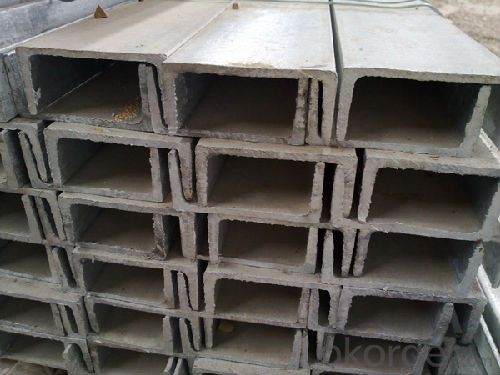
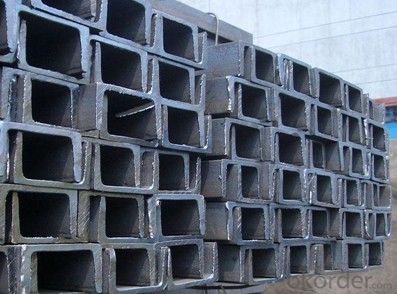
- Q: What's the difference between channel type 25a#, 25b# and 25c#?
- Because the channel steel is a cross section steel strip with groove shape. Its specifications, such as a*b*c (here, a, B, C, only letters, no other meaning and letters), a means waist height of a mm, leg width of B mm, waist thickness of C mm channel. For example: channel type 25a#, specifications for 250*78*7, which means waist height (a) is 250mm, leg width (b) 78mm, waist thickness (c) 7mm
- Q: What are the different applications of steel channels in the automotive industry?
- Steel channels are widely used in the automotive industry for various applications. They are commonly utilized in the construction of vehicle frames, where they provide structural support and help enhance the rigidity and strength of the frame. Steel channels also find use in the manufacturing of suspension systems, providing stability and durability. Additionally, they are used in the production of vehicle doors and body panels, offering reinforcement and protection. Overall, steel channels play a vital role in ensuring the safety and performance of automobiles.
- Q: How do steel channels resist impact and vibrations?
- Steel channels resist impact and vibrations due to their high strength and stiffness properties. The structural design of steel channels allows them to distribute and absorb the energy generated by impact or vibrations, minimizing any potential damage or deformation. Additionally, the inherent damping characteristics of steel help to dissipate vibrations, reducing their impact on the overall structure.
- Q: How do steel channels contribute to the overall strength of a structure?
- There are multiple ways in which steel channels contribute to the overall strength of a structure. To begin with, they offer structural support and stability by evenly distributing the load across the structure. The shape of steel channels, which includes a wide base and tapered edges, allows them to bear more weight and resist bending or buckling when faced with heavy loads. Moreover, steel channels enhance the rigidity of a structure by preventing lateral movement or twisting. They function as beams, establishing a framework that combats deformation and ensures the structure maintains its shape and integrity, even under challenging circumstances like earthquakes or strong winds. Furthermore, steel channels can be strategically positioned in crucial areas of a structure, such as load-bearing walls or columns, to reinforce these vulnerable points. This reinforcement significantly increases the overall strength and durability of the structure, reducing the risk of structural failure. In addition, steel channels possess high tensile strength, enabling them to withstand stretching or elongation when subjected to tension. This property is particularly important for structures that encounter dynamic loads, like bridges or tall buildings. Steel channels play a role in distributing and absorbing these dynamic forces, preventing excessive deflection or deformation that could jeopardize the stability of the structure. In conclusion, the contribution of steel channels to the overall strength of a structure is significant. They provide structural support, enhance rigidity, reinforce vulnerable points, and offer high tensile strength. Their ability to distribute loads, resist bending or buckling, and withstand dynamic forces makes them an essential component of any robust and long-lasting structure.
- Q: Can steel channels be used for equipment enclosures?
- Yes, steel channels can be used for equipment enclosures. Steel channels are structural components that are typically used to provide support and stability to various structures, including equipment enclosures. They are made from strong and durable steel materials, which make them ideal for protecting equipment from external elements and potential damage. Steel channels can be easily customized and fabricated to fit the specific dimensions and requirements of the equipment enclosure. Additionally, steel channels can also be further reinforced with additional steel components to enhance the overall strength and security of the enclosure. Overall, steel channels provide a reliable and robust solution for constructing equipment enclosures.
- Q: What are the different types of connections used for steel channels?
- There are several types of connections used for steel channels, depending on the specific application and structural requirements. Some of the common types of connections include: 1. Welded Connections: Welding is a widely used method to connect steel channels. It involves melting the ends of the channels and fusing them together using heat. Welded connections are strong and durable, providing excellent load-bearing capacity. 2. Bolted Connections: Bolted connections involve using bolts, nuts, and washers to connect steel channels. Holes are drilled in the channels, and bolts are inserted through these holes and tightened with nuts. Bolted connections offer ease of installation, flexibility for disassembly, and can be adjusted or replaced if necessary. 3. Riveted Connections: Riveting is an older method of connection that involves using rivets to join steel channels. Rivets are inserted through pre-drilled holes in the channels and then hammered or pressed to secure them in place. Riveted connections provide strength and stability, but they are less common nowadays due to the labor-intensive installation process. 4. Composite Connections: Composite connections combine different methods of connection to enhance the overall strength and performance. For example, a composite connection may involve a combination of welding and bolting, providing the benefits of both methods. These connections are often used in high-load applications or where specific design requirements need to be met. 5. Moment Connections: Moment connections are used to transfer bending moments between steel channels. These connections are designed to withstand rotational forces and provide stability. Moment connections are typically welded and require careful design and engineering to ensure proper load distribution and structural integrity. It is important to note that the choice of connection type depends on factors such as the load requirements, structural design, fabrication capabilities, and project specifications. Consulting a structural engineer or a professional with expertise in steel channel connections is recommended to ensure the appropriate type of connection is chosen for a specific application.
- Q: What are the common safety considerations in the design of steel channels?
- Some common safety considerations in the design of steel channels include ensuring proper load-bearing capacity, structural stability, and resistance to deformation or buckling under applied loads. Additionally, factors such as corrosion resistance, fire resistance, and overall durability are also important to ensure the long-term safety and performance of steel channels. Adequate measures must be taken to prevent any potential hazards related to sharp edges, exposed fasteners, or other potential injury risks. Proper installation techniques and adherence to industry standards and codes are essential to ensure the safety of steel channel systems.
- Q: Can steel channels be custom-made?
- Yes, steel channels can be custom-made. Steel channels are commonly used in construction and engineering projects, and their dimensions, length, and shape can be customized to meet specific requirements. Customization may involve altering the size, thickness, and material grade of the steel channels to suit the project's needs. This flexibility allows for a wide range of applications and ensures that steel channels can be tailored to fit various structural and design specifications.
- Q: What are the limitations of using steel channels?
- There are several limitations associated with using steel channels in various applications. Firstly, one of the main limitations is cost. Steel channels can be relatively expensive compared to other materials such as wood or certain types of plastics. This higher cost can make it less feasible for certain projects or industries with strict budget constraints. Secondly, steel channels are generally quite heavy and bulky, which can make transportation and installation more challenging. The weight of steel can require additional labor and equipment, increasing overall project costs and potentially limiting its use in certain applications where weight is a critical factor. Another limitation is corrosion. Steel is prone to rusting and corrosion over time, especially in environments with high moisture or exposure to certain chemicals. This corrosion can weaken the structural integrity of the steel channel and may require regular maintenance or protective coatings to prevent or slow down the corrosion process. Additionally, steel channels have limitations in terms of design flexibility. Unlike other materials such as wood or plastic, steel channels are not easily shaped or molded into complex or intricate designs. This lack of design flexibility can limit their use in certain architectural or decorative applications where aesthetic considerations are important. Lastly, steel channels can conduct heat and electricity, which may not be desirable in certain applications. For example, in electrical systems or sensitive electronic equipment, steel channels may need to be insulated or replaced with non-conductive materials to prevent electrical hazards or interference. Overall, while steel channels are strong and durable, they do come with limitations in terms of cost, weight, corrosion, design flexibility, and electrical conductivity. These limitations need to be carefully considered when deciding on the suitability of steel channels for a particular project or application.
- Q: What are the different types of connections for steel channels in modular office systems?
- There are various types of connections used for steel channels in modular office systems, including bolted connections, welded connections, and adjustable connections. Bolted connections involve using bolts and nuts to secure the channels together, providing flexibility for disassembly and reassembly. Welded connections involve fusing the steel channels together using heat, creating a strong and permanent connection. Adjustable connections allow for fine-tuning and leveling of the channels, ensuring proper alignment and stability in the modular office system.
Send your message to us
U CHANNEL GB and JIS standard High Quality Hot Rolled
- Loading Port:
- Tianjin
- Payment Terms:
- TT or LC
- Min Order Qty:
- 25 m.t.
- Supply Capability:
- 20000000 m.t./month
OKorder Service Pledge
OKorder Financial Service
Similar products
Hot products
Hot Searches
Related keywords
